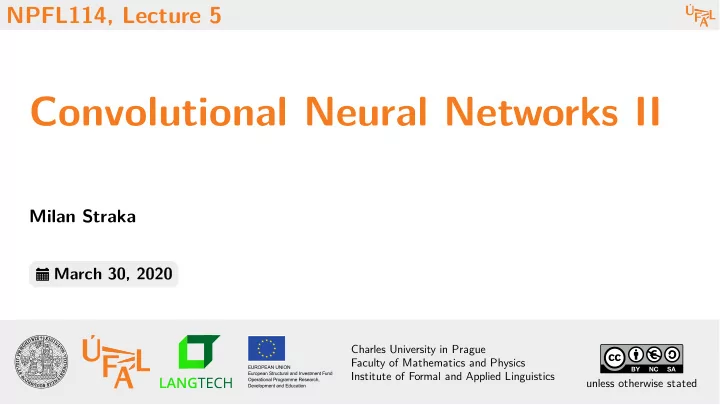

NPFL114, Lecture 5 Convolutional Neural Networks II Milan Straka March 30, 2020 Charles University in Prague Faculty of Mathematics and Physics Institute of Formal and Applied Linguistics unless otherwise stated
Designing and Training Neural Networks Designing and training a neural network is not a one-shot action, but instead an iterative procedure. When choosing hyperparameters, it is important to verify that the model does not underfit and does not overfit. Underfitting can be checked by increasing model capacity or training longer. Overfitting can be tested by observing train/dev difference and by trying stronger regularization. Specifically, this implies that: We need to set number of training epochs so that training loss/performance no longer increases at the end of training. Generally, we want to use a large batchsize that does not slow us down too much (GPUs sometimes allow larger batches without slowing down training). However, with increasing batch size we need to increase learning rate, which is possible only to some extent. Also, small batch size sometimes work as regularization (especially for vanilla SGD algorithm). NPFL114, Lecture 5 Refresh ResNetModifications CNNRegularization EfficientNet TransferLearning TransposedConvolution 2/53
Main Takeaways From Previous Lecture Convolutions can provide local interactions in spacial/temporal dimensions shift invariance much less parameters than a fully connected layer 3 × 3 Usually repeated convolutions are enough, no need for larger filter sizes. When pooling is performed, double number of channels. Final fully connected layers are not needed, global average pooling is usually enough. Batch normalization is a great regularization method for CNNs, allowing removal of dropout. Small weight decay (i.e., L2 regularization) of usually 1e-4 is still useful for regularizing convolutional kernels. NPFL114, Lecture 5 Refresh ResNetModifications CNNRegularization EfficientNet TransferLearning TransposedConvolution 3/53
ResNet – 2015 (3.6% error) Figure 1 of paper "Deep Residual Learning for Image Recognition", https://arxiv.org/abs/1512.03385. NPFL114, Lecture 5 Refresh ResNetModifications CNNRegularization EfficientNet TransferLearning TransposedConvolution 4/53
ResNet – 2015 (3.6% error) Figure 2 of paper "Deep Residual Learning for Image Recognition", https://arxiv.org/abs/1512.03385. NPFL114, Lecture 5 Refresh ResNetModifications CNNRegularization EfficientNet TransferLearning TransposedConvolution 5/53
ResNet – 2015 (3.6% error) Figure 5 of paper "Deep Residual Learning for Image Recognition", https://arxiv.org/abs/1512.03385. NPFL114, Lecture 5 Refresh ResNetModifications CNNRegularization EfficientNet TransferLearning TransposedConvolution 6/53
ResNet – 2015 (3.6% error) Table 1 of paper "Deep Residual Learning for Image Recognition", https://arxiv.org/abs/1512.03385. NPFL114, Lecture 5 Refresh ResNetModifications CNNRegularization EfficientNet TransferLearning TransposedConvolution 7/53
ResNet – 2015 (3.6% error) The residual connections cannot be applied directly when number of channels increase. The authors considered several alternatives, and chose the one where in case of channels 1 × 1 increase a convolution is used on the projections to match the required number of channels. Figure 3 of paper "Deep Residual Learning for Image Recognition", https://arxiv.org/abs/1512.03385. NPFL114, Lecture 5 Refresh ResNetModifications CNNRegularization EfficientNet TransferLearning TransposedConvolution 8/53
ResNet – 2015 (3.6% error) Figure 4 of paper "Deep Residual Learning for Image Recognition", https://arxiv.org/abs/1512.03385. NPFL114, Lecture 5 Refresh ResNetModifications CNNRegularization EfficientNet TransferLearning TransposedConvolution 9/53
ResNet – 2015 (3.6% error) Figure 1 of paper "Visualizing the Loss Landscape of Neural Nets", https://arxiv.org/abs/1712.09913. NPFL114, Lecture 5 Refresh ResNetModifications CNNRegularization EfficientNet TransferLearning TransposedConvolution 10/53
ResNet – 2015 (3.6% error) Training details: batch normalizations after each convolution and before activation SGD with batch size 256 and momentum of 0.9 learning rate starts with 0.1 and is divided by 10 when error plateaus no dropout, weight decay 0.0001 during testing, 10-crop evaluation strategy is used, averaging scores across multiple scales – the images are resized so that their smaller size is in {224, 256, 384, 480, 640} NPFL114, Lecture 5 Refresh ResNetModifications CNNRegularization EfficientNet TransferLearning TransposedConvolution 11/53
Recommend
More recommend